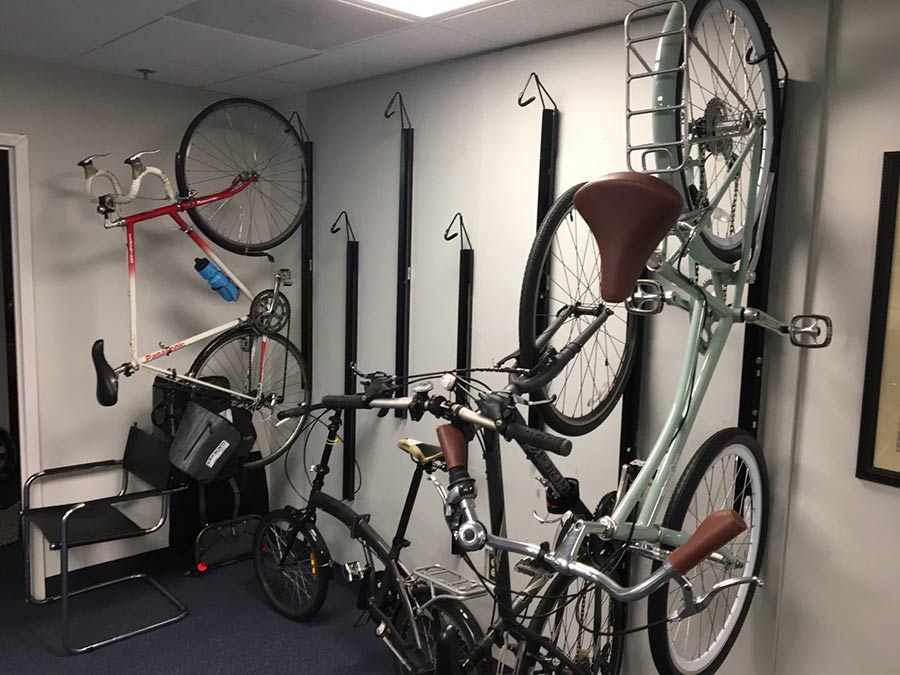The Transportation Research Board (TRB) Annual Meeting held in Washington DC is the largest transportation conference in the world, with over 10,000 attendees and over 5,000 presentations and posters covering all aspects of transportation.
The program centers around the presentations of the top academic research being conducted across the world at universities, government agencies, and planning organizations. While its easy to get swallowed up in the “Transportation-Industrial Complex,” there are some great presentations and papers focusing on bicycling, bicycling infrastructure, and urban mobility.  Unique bicycle infrastructure on Pennsylvania Avenue that solves problems and adds value.
Unique bicycle infrastructure on Pennsylvania Avenue that solves problems and adds value.
The most prevalent topics at this conference are naturally those that can provide enough quality data to be analyzed and studied. For bicycle transportation, this is measured in bike share, mode-share/participation, and crashes. Bike share is a bonanza of data. Companies and operators know the who, when, and where of their riders. How we use that data to better plan our infrastructure was a common theme at the conference.
Whether it’s better siting of bike share bikes to increase ridership among certain demographics, or if it’s designing networks of protected bike lanes to accommodate high-use streets and corridors, this data can help give city planners and officials incredible visibility on how people move through their streets. The key will be if we can help connect the researchers and academics who have collected and analyzed the data, with the practitioners who could most benefit from it. 
Here’s what happens when multiple bikeshare companies vie for the same space in DC. And mix in high winds.
Another intriguing topic at TRB was the social-economic impact of bike infrastructure. Researchers from Portland State University presented their work on valuing bicycle infrastructure by analyzing property values within certain distances of bike facilities to gauge consumer preferences.
Their research found positive and statistically significant impacts on property values the closer the property was located to multi-use paths and protected bike lanes that feed into a greater network of bike facilities. This provides excellent talking points for municipal planners, engineers, and elected officials when discussing the benefits of bicycle infrastructure with the public.
In addition to academic work, several case studies were presented. One of the most exciting was the Midway Cycle Track in Cleveland Ohio. Yes, that’s right, Cleveland. A bold plan for a two-way cycle track right through the heart of downtown and in front of city hall, the Midway Cycle Track will be part of a world-class bicycling network that will connect neighborhoods and help make Cleveland one of the most bike friendly cities in the US.
At most bicycling conferences, you expect to hear about what the historically progressive cycling cities like Boulder, Portland and San Francisco are doing. But to hear about Rust-Belt Cleveland, and their plan for 60-miles of incredible bike infrastructure, gave me hope about what can be achieved with the right approach, planning, and advocacy. 
League of American Cyclists walk the talk with the employee bike parking. Saris Bike Tracs have followed their many office moves.
A trip to Washington DC would not be complete without a stop to visit our friends at the League of American Cyclists. Often in the face of political headwinds, this outstanding organization keeps up the fight to make our streets and communities safer and more bike-friendly.
Building on the positivity and optimism we felt after TRB, we're encouraged that there are organizations staffed with incredible people working on our behalf to push the bicycle advocacy movement forward and be our voice in DC.
See you next year TRB!
Into the Belly of the “Transit-Industrial Complex” Beast
